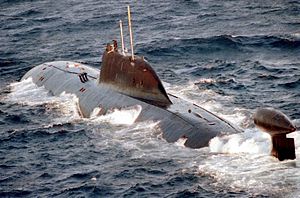The K-322 Kashalot was an Akula-class submarine in the Russian Navy.
 Kashalot
| |
| History | |
|---|---|
| Name | K-322 |
| Builder | Amur Shipyard, Komsomolsk-on-Amur |
| Yard number | 513 |
| Laid down | 5 September 1986 |
| Launched | 18 July 1987 |
| Commissioned | 30 December 1988 |
| Renamed |
|
| Namesake | Kashalot |
| Decommissioned | 9 October 2019 |
| Identification | Pennant number: 985 |
| Status | Decommissioned |
| General characteristics | |
| Class and type | Akula-class submarine |
| Displacement | |
| Length | 110.3 m (361 ft 11 in)[1] maximum |
| Beam | 13.6 m (44 ft 7 in) |
| Draught | 9.7 m (31 ft 10 in) |
| Propulsion |
|
| Speed |
|
| Endurance | 100 days[4] |
| Test depth | 480 m (1,570 ft) |
| Complement | 73[5] |
| Sensors and processing systems |
|
| Electronic warfare & decoys | |
| Armament | |
| Notes | |
Design
editProject 971 has a double-hull design. The robust body is made of high quality alloy steel with σт = 1 GPa (10,000 kgf / cm2). To simplify the installation of equipment, the boat was designed using zonal blocks, which made it possible to transfer a significant amount of work from the cramped conditions of the sub's compartments directly to the workshop. After completion of the installation, the zonal unit is “rolled” into the hull of the boat and connected to the main cables and pipelines of the ship's systems.[6] A two-stage damping system is used: all mechanisms are placed on damped foundations, in addition, each zone unit is isolated from the body by rubber-cord pneumatic shock absorbers.[6] In addition to reducing the overall noise level of nuclear submarines, such a scheme can reduce the impact of underwater explosions on equipment and crew.[7][6] The boat has a developed vertical tail unit with a streamlined boule, in which the towed antenna is located. Also on the submarine are two reclining thrusters and retractable bow horizontal rudders with flaps. A feature of the project is the smoothly mated connection of the tail unit to the hull. This is done to reduce noise-generating hydrodynamic eddies.
Power supply is carried out by a nuclear power plant. The lead boat, K-284 Akula, is equipped with an OK-650M.01 pressurized water-cooled nuclear reactor. On later orders, the AEU has minor improvements. Some sources report that subsequent boats are equipped with OK-9VM reactors.[8] The thermal power of the reactor is 190 MW, the shaft power is 50,000 liters. with. Two auxiliary electric motors in the hinged outboard columns have a capacity of 410 hp. with., there is one diesel generator ASDG-1000.
Construction and career
editThe submarine was laid down on 5 September 1986 at Amur Shipyard, Komsomolsk-on-Amur. Launched on 18 July 1987 and commissioned on 30 December 1988.[9]
The boat was adopted into the Navy on 25 January 1989. On 1 March, he was included in the Red Banner Pacific Fleet. He became a part of the 45th Submarine Division of the second submarine KTOF based in Kamchatka, in the Krasheninnikov Bay (Rybachy settlement).
In the summer of 1990, she completed the tasks of combat service. The duration of tracking foreign submarines in the campaign was more than 14 days (354 hours). This was the best result at that time, tracking time for the foreign submarine exceeded the best achievements of the submarines of the USSR Navy. On 13 April 1993, he received the name Kashalot.
In March 1998, the 2nd FPL of the Pacific Fleet was transferred to the 10th DPL with the former base.
In the TSD Zeya in September 2002, he was transported to the ZSO Vostok, the reactor core was unloaded, before being put into medium repair.
From 2013 to 2014, she was on the territory of the Federal State Unitary Enterprise Amur Shipyard in Komsomolsk-on-Amur, awaiting repairs.
In January 2015, the Indian Navy's leadership submitted an offer to lease the Kashalot nuclear submarine after being repaired.[10]
On 10 October 2019, a decision was made on the inexpediency and technical impossibility of further repairs and on the disposal of the submarine in May 2020.[11] Disposal work began in 2020 on the basis of the Amur shipyard.[12] Instead of K-322, India plans to lease K-331 Magadan.
Citations
edit- ^ Podvodnye Lodki, Yu.V. Apalkov, Sankt Peterburg, 2002, ISBN 5-8172-0069-4
- ^ "Marine Nuclear Power:1939 – 2018" (PDF). July 2018. Retrieved 30 December 2022.
- ^ Saunders, Stephen, ed. (2008). Jane's Fighting Ships 2008-09. Coulsdon, UK: Jane's Information Group. p. 644. ISBN 978-0-71062-845-9.
- ^ Apalkov, Yu. V. (2003). Подводные лодки ВМФ СССР [Submarines of the Soviet Navy]. Sankt-Peterburg: Galeya Print. ISBN 5-8172-0071-6.
- ^ "Specification: SSN Akula Class (Bars Type 971) Attack Submarine, Russia". Naval-technology.com. Archived from the original on 5 June 2011.
- ^ a b c http://www.rosprom.gov.ru/news.php?id=3053&fcat=0 [dead link]
- ^ "Archived copy". Archived from the original on 29 January 2012. Retrieved 18 September 2021.
{{cite web}}: CS1 maint: archived copy as title (link) - ^ Apalkov, Yu.V. (2002). Подводные лодки. St. Petersburg: Галея Принт», Санкт.
- ^ "Nuclear-Powered Submarines - Project 971". russianships.info. Retrieved 18 September 2021.
- ^ "Индия просит передать ей в аренду АПЛ "Кашалот"". Центральный Военно-Морской Портал. Retrieved 18 September 2021.
- ^ "В России за шесть лет "растаяли" восемь АПЛ". ВПК.name (in Russian). 27 May 2019. Retrieved 18 September 2021.
- ^ "Подводная лодка К-322, "Кашалот". Проект 971". www.deepstorm.ru. Retrieved 18 September 2021.